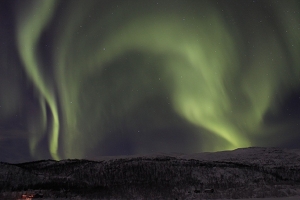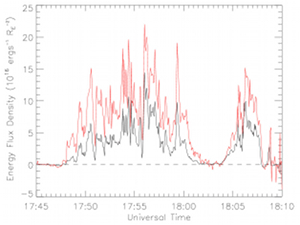Cluster finds source of aurora energy boost
10 April 2013
A new study based on data from ESA's Cluster mission has revealed the importance of bursty bulk flows (BBFs) - fast streams of plasma that are launched towards Earth during the magnetic substorms that give rise to bright aurorae. By modelling these fast plasma streams using a kinetic approach, scientists have discovered that earlier studies based on magnetohydrodynamics tended to underestimate their role in the energy transfer during magnetic substorms. The new, more accurate description suggests that BBFs can carry up to one third of the total energy transferred during a substorm; in such cases, BBFs represent a major contributor to the brightening of aurorae. |
| A bright aurora illuminating the sky in the vicinity of Tromsø, Norway. Credit: ESA - Sara Mazrouei |
The light show of aurorae has been observed close to Earth's polar regions for millennia, and for centuries a link between their occurrence and the activity of the Sun was apparent. Only with the aid of satellite-based measurements in the late twentieth century, however, could scientists begin to tackle the physical mechanisms causing this spectacular phenomenon.
Bright aurorae arise during magnetic substorms, violent events in Earth's magnetic environment, the magnetosphere. Substorms result from variations in the solar wind, the stream of electrically charged particles released by the Sun. When the solar wind changes in such a way as to invert the orientation of the interplanetary magnetic field, the tail of the magnetosphere gets compressed and blows powerful streams of highly-energetic plasma both towards Earth and in the opposite direction. As a consequence, plasma particles can infiltrate the upper layer of Earth's atmosphere – the ionosphere – producing breath-taking aurorae but also disturbing telecommunication networks and GPS.
"While we can grasp quite well the overall picture underlying magnetic substorms and aurorae, we are still far from the detailed understanding that would allow us to predict phenomena in Earth's magnetosphere," says Jinbin Cao from the Space Science Institute at Beihang University in Beijing, China. "In our study, we tried to achieve a more accurate description of the magnetospheric plasma by applying an alternative approach to the analysis of bursty bulk flows (BBFs), which are very fast streams of particles launched towards Earth during a substorm," he adds.
One of the vexed questions in the study of magnetic substorms concerns how exactly energy is transported across the magnetosphere, and in particular to Earth, during these events. Exploiting data from ESA's Cluster mission, Cao and his collaborators have revealed the importance of BBFs, a previously neglected mechanism. Surprisingly, BBFs turned out to be a major player in the energy transfer during the magnetic substorm that was analysed in this study.
"BBFs are short-lived, lasting typically ten to twenty minutes, and previous studies considered their contribution to the total energy transferred in a substorm to be marginal, adding up to only 5 per cent," explains Cao.
"However, those investigations were based on a very approximate description of the dynamics of plasma in the magnetosphere. In our study, we have implemented a more detailed modelling of the plasma, which has allowed us to discover that BBFs can carry much larger amounts of energy than previously thought – up to 35 per cent of the total energy that eventually reaches Earth and can be measured during an aurora."
| A magnetic substorm in Earth's magnetosphere that gives rise to bright aurorae close to Earth's polar regions. Credit: ESA/AOES medialab |
Studying the dynamics of plasma is notoriously complex, and even more so in the magnetic environment of our planet. Collision dominated plasmas, such as those in planetary ionospheres, are usually modelled in terms of magnetohydrodynamics (MHD), an approach which treats all particles in the plasma as part of a single fluid. In Earth's magnetosphere, however, the experimental constraints coming from in situ measurements are so precise that they reveal that the MHD approximation is not always applicable.
"Whereas MHD is satisfactory to study the behaviour of collision dominated plasmas in distant astronomical sources, it breaks down when we try to model collisionless plasma phenomena in Earth's magnetosphere," says co-author George Parks from the University of California, Berkeley, USA.
"Directly sampling the properties of particles in the magnetospheric plasma forces us to drop the MHD approach, which only describes average properties. Instead we must study the kinetic behaviour of the individual particles. After all," he adds, "it is in the deviations from the average picture that we can read the signature of the physical processes at play."
The analysis conducted by Cao and his colleagues is based on data collected with the Cluster Ion Spectrometry (CIS) experiment, as one of the four Cluster spacecraft crossed the tail of the magnetosphere during a magnetic substorm on 30 July 2002. On this occasion, the experiment detected a BBF streaming towards Earth at velocities up to 1800 km/s.
"The measurements performed with Cluster gave us a very precise view of the density and velocity of the ions in the plasma over a very broad range of energies," comments Iannis Dandouras from the Institut de Recherche en Astrophysique et Planétologie (CNRS) and Université Paul Sabatier in Toulouse, France, who is the principal investigator of the CIS experiment.
"The data revealed that a BBF cannot be described as a single fluid, but that it consists of at least two components: a fast flow of higher-energy ions, and a second component made up of less energetic and slower ions," he says.
The study conducted by Cao and his colleagues suggests that the role of BBF in substorm energy transport is more complicated than previously thought, since the velocity distribution of ions in the BBF must be taken into account as well as the usual MHD parameters that describe the fluid – density, velocity and pressure.
With these data, the scientists were able, for the first time, to assess the actual contribution of BBFs to the energetics of magnetic substorms. They calculated the energy transported by BBFs during the substorm that they analysed using the kinetic approach, which is larger than the value calculated within the MHD approximation and amounts to about one third of the total energy transferred during this particular substorm. Further studies of these phenomena in a larger number of events are ongoing; preliminary results suggest that, for most substorms, the energy transported by BBFs is larger when calculated using the kinetic approach rather than the MHD approximation.
"This result reveals how an approximate description of the magnetospheric plasma has long underestimated the importance of a major phenomenon such as bursty bulk flows and highlights the need to model space plasma with ever greater detail," says Matt Taylor, Cluster Project Scientist at ESA. "This will not only advance our understanding of space weather in Earth's magnetosphere, but it will also bring new insight into the study of plasma in a variety of astrophysical environments," he concludes.
Notes for editors
This article is based on results described in the paper by J. Cao, et al., "Kinetic analysis of the energy transport of bursty bulk flows in the plasma sheet", 2013, Journal of Geophysical Research: Space Physics, 118; doi: 10.1029/2012JA018351.
The study presented here is based on data gathered with the Cluster Ion Spectrometry (CIS) experiment on board one of the four Cluster spacecraft (C1) on 30 July 2002.
Cluster is a constellation of four spacecraft flying in formation around Earth. It is the first space mission able to study, in three dimensions, the natural physical processes occurring within and in the near vicinity of the Earth's magnetosphere. Launched in 2000, it is composed of four identical spacecraft orbiting the Earth in a pyramidal configuration, along a nominal polar orbit of 4 × 19.6 Earth radii (1 Earth radius = 6380 km). Cluster's payload consists of state-of-the-art plasma instrumentation to measure electric and magnetic fields over wide frequency ranges, and key physical parameters characterising electrons and ions from energies of near 0 eV to a few MeV. The science operations are coordinated by the Joint Science Operations Centre (JSOC) at the Rutherford Appleton Laboratory, United Kingdom, and implemented by ESA's European Space Operations Centre (ESOC), in Darmstadt, Germany.
Contacts
Jinbin Cao
Space Science Institute
Beihang University
Beijing, China
Email: jbcao![]() nssc.ac.cn
nssc.ac.cn
Phone: +86-10-62582644
George Parks
University of California, Berkeley, USA
Email: parks![]() ssl.berkeley.edu
ssl.berkeley.edu
Phone: +1-510-643-5512
Iannis Dandouras
Principal Investigator of the Cluster Ion Spectrometry experiment (CIS)
Institut de Recherche en Astrophysique et Planétologie (CNRS)
and Université Paul Sabatier
Toulouse, France
Email: Iannis.Dandouras![]() irap.omp.eu
irap.omp.eu
Phone: +33-5-61558320
Matt Taylor
Cluster Project Scientist
Research and Scientific Support Department
Directorate of Science & Robotic Exploration
ESA, The Netherlands
Email: mtaylor![]() rssd.esa.int
rssd.esa.int
Phone: +31-71-565-8009



